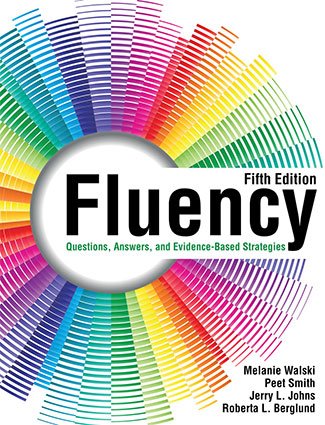
Melanie Walski joined the NIU College of Education in the fall of 2016 as a visiting assistant professor. She was hired as tenure-track in 2017.
Peet Smith came 12 months afterward, arriving in 2018.
One year later, during the autumn semester of 2019, the two assistant professors in the Department of Curriculum and Instruction celebrated the publication of their first book: “Fluency: Questions, Answers, and Evidence-Based Strategies.”
Their names are not alone on the cover, though.
Former faculty members Jerry Johns and Roberta L. Berglund are listed as the third and fourth co-authors of the book, now in its fifth edition.
But Walski and Smith are justifiably proud and excited to take ownership of this version, the first in 10 years and one they say explores, explains and encompasses a decade of change in reading fluency, including integration of instructional technology.
Nearly three-quarters of the content in the first section, and nearly a third in the second section, is new. The foundational content that remains, meanwhile, provides a rich and historical picture of what teachers were doing in 2009.
“We really wanted to update it and put it into the context of what’s going on in foundational reading now, especially in fluency instruction, and situate it within the Common Core Standards,” Walski says.
“Practices change in classrooms. More research comes out. We learn more about things, and so we can update our practices to reflect that,” she adds. “It’s no longer about timed, repeated readings, but that fluency is a multidimensional component of literacy.”
 Educators of all types – teachers, reading specialists and other school professionals – will find more than 30 ready-to-use strategies to help them understand and strengthen fluency instruction for students in regular classrooms, resource rooms and Response to Intervention programs.
Educators of all types – teachers, reading specialists and other school professionals – will find more than 30 ready-to-use strategies to help them understand and strengthen fluency instruction for students in regular classrooms, resource rooms and Response to Intervention programs.
Strategies offered are more student-centered rather than teacher-centered, Smith says.
“Part One is focused on the literature and really develops the rationale for why we were doing this fifth edition,” Smith says. “The second part was entirely focused on specific strategies that teachers can use in the classroom, so those really had to be updated as well to aim instruction at English Learners as we’ve seen a big influx of English Learners as the fastest growing population in K-12 schools.”
Guided and mentored by Johns, Walski and Smith made sure to produce a resource that they would have used during their own days teaching in elementary classrooms.
Among the questions it promises to answer: Are you trying to help your students become more fluent readers? Are you doing progress monitoring? Do you think that differentiating fluency interventions can help you respond to individual differences among your students?
“The book is a really nice balance of explaining and providing the rational for why this book is needed now, as well as instructional strategies,” Walski says, “because that’s what teachers want. They want things they can do in their classroom, and they also want to know why it’s important.”
Keeping teachers in mind “was such a big part of it. We thought of that the whole time we were putting this book together,” Smith says.
“ ‘If I were a teacher right now, what would I want to flip to? What would I want this section to look like? How would I want this to be organized?’ ” she adds. “We work directly with pre-service teachers and in-service teachers now, and I think that helped influence the way we thought about the text.”
 Simplicity is key and intentional to lift students to the goal of comprehension.
Simplicity is key and intentional to lift students to the goal of comprehension.
“Teachers are really busy,” Walski says. “I was a teacher for a long time. Peet was a teacher. You want to be able to open something and know it is appropriate for my student’s needs right now. We aligned everything to specific qualities and components of reading, and so it’s very easy for teachers to reference and find different strategies that would be appropriate for their students’ needs.”
“A student might struggle with speed or accuracy,” Smith adds. “You can flip through the text, and we have a graphic organizer that says, ‘This strategy is focused on accuracy.’ ”
Johns, who came to the young colleagues with the offer to shepherd this fifth edition to press, proved an empowering and insightful facilitator and adviser.
His assistance trod a prudent balance of hands-off and hands-on, they say.
“Jerry Johns is very invested in developing new NIU faculty,” Walski says. “He approached us. He provided us a way to learn how to put a book together and how to work with publishers. He very much walked us through the process, and mentored us through the process. We were really fortunate to be connected with him. Having someone like Jerry to mentor us was invaluable.”
From Day One, she adds, “he told us that this was our project.”

Like any good teacher, however, the NIU Distinguished Teaching Professor Emeritus and member of the Reading Hall of Fame prompted his new co-authors to fully deliberate their concepts and decisions.
“We did make a very large structural change,” Walski says, “and updated the language on how you categorize struggling readers. Jerry was completely open to all of our ideas. He participated in all of these conversations, and was very willing to listen and to look at the research. He was highly supportive through all of that.”
Smith appreciated those exercises – not to mention the confidence.
“He said, ‘Whatever you want to do to the book, you can do to the book.’ That was, one, a big responsibility, but, two, it was really great to hear that he trusted us. It had been through four editions with him,” she says. “We proposed a few ideas, and we went back and forth a few times, and then came up with the final ideas. He’d say, ‘What do you want to do? Give me a rationale for it. OK, I totally get it. Let’s go in that direction.’ ”
Now the two feel ready for their next endeavor – a new book – for which work already has begun.
Thanks to creating the fifth edition of “Fluency,” they have been introduced to publishers.
And, thanks to Johns, they understand the process and the commitment it demands to complete a book.
“It gives you the sense of that self-efficacy component that’s so important to just staying motivated to getting things accomplished and saying on task,” Smith says. “It took us almost a year from start to finish, staying that motivated that whole time: ‘I can do it. We can do it.’ ”

